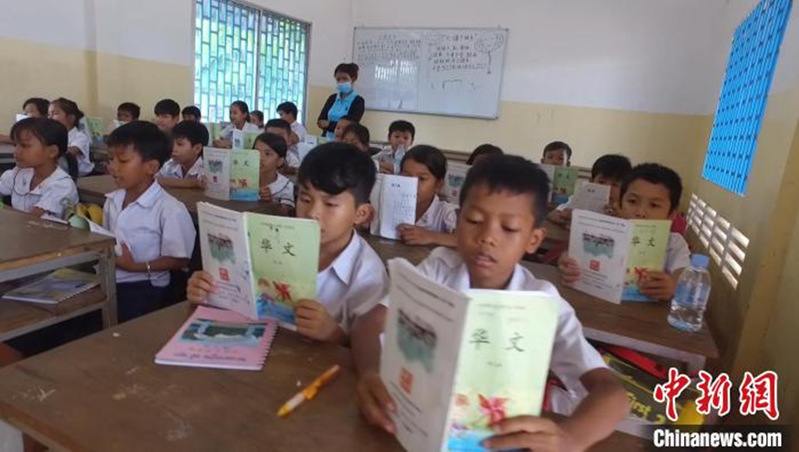- ABOUT JNU
- ADMISSION
-
ACADEMICS
- Schools and Colleges
-
Departments and Programs
- Arts College of
- Chinese Language and Culture College of
- Economics College of
- Electrical and Information Engineering College of
- Foreign Studies College of
- Information Science and Technology College of
- Environment School of
- Humanities School of
- International Business School
- International Studies School of
- Journalism and Communication College of
- Law School
- Liberal Arts College of
- Life Science and Technology College of
- Management School of
- Marxism School of
- Medicine School of
- Pharmacy College of
- Physical Education School of
- Science and Engineering College of
- Shenzhen Tourism College
- Research Institute
- Research Center
- Programs in English
- Majors
- Study Abroad
- Online Learning
- RESEARCH
- CAMPUS LIFE
- JOIN US
Chinese Language Textbooks from Jinan University Adopted by 58 Schools in Cambodia
Author: Guo Jun, Su Yunsheng
Publisher: China News Network
Date: April 16, 2025
Recently, a vibrant Chinese language class was observed at a Chinese literature school in Phnom Penh, Cambodia, where students engaged in situational dialogue exercises guided by teachers adhering to structured lesson plans. This successful implementation is a result of a collaboration between the College of Chinese Language and Culture of Jinan University and the Cambodian Chinese Council, which has developed a comprehensive series of national textbooks, including Chinese Language, Mathematics, and Common Sense.
Widespread Adoption and Impact
Since their introduction in 2016, these textbooks have been selected by 58 Chinese schools in Cambodia, benefitting over 50,000 students during this period. As a vital hub for overseas Chinese in Southeast Asia, Chinese education in Cambodia serves not only as a medium for language preservation but also as a crucial factor in facilitating the success of local students through cultural understanding.

(Learning Chinese: Students in Cambodia Utilize Jinan University Textbooks.)
Historically, Cambodian Chinese language education faced challenges such as a lack of textbook adaptability and a limited range of teaching methods. To address these issues, the School of Chinese Language and Literature at Jinan University collaborated with the Cambodian Chinese Council to create a textbook system that integrates scientific principles with local relevance.
Development of Textbooks
Zhang Li, Director of the International Promotion Center for Chinese Language at Jinan University, explained that the primary school versions of the Chinese Language, Mathematics, and Common Sense textbooks involved Cambodian teachers in the proofreading phase during development, ensuring that local contexts were considered. This collaborative approach included multiple rounds of revisions and adjustments.
The textbooks not only feature traditional Chinese cultural elements, such as festivals and historical narratives, but also align their teaching content with the local Cambodian context. Covering more than 130 books from primary to junior high school, they encompass subjects essential for learning Chinese.
Educational Effectiveness
The textbooks' design emphasizes a gradual learning process, starting with pinyin and stroke orders, progressing to vocabulary and sentence structures, culminating in reading comprehension. By incorporating diverse teaching methodologies—such as situational dialogues, group tasks, and game-like challenges—students' engagement and interest are significantly stimulated.
The effectiveness of these textbooks is supported by quantifiable results. According to the Chinese Proficiency Test (HSK), 88% of primary school graduates have passed HSK Level 4, and over 90% of junior high school graduates have passed HSK Level 5, with half of the students achieving HSK Level 6.
A survey conducted by the Cambodia China Council revealed that 98% of students express satisfaction with the textbooks, praising their engaging content and appropriate difficulty. Teachers noted that lesson preparation burdens have lessened, and their teaching confidence has grown. Zhang Li further emphasized that these textbooks not only improve teaching methods but also advance the professional development of educators.
Future Developments
Looking ahead, the textbook development team plans to enhance educational resources with supporting digital tools such as online courses and teaching applications to cater to contemporary learning habits. Zhang Li mentioned plans for collaboration with Cambodia to develop an online platform that integrates videos and interactive exercises, enabling students to learn irrespective of time and geographical constraints.
As of 2025, this ongoing effort in Chinese language education in Cambodia signifies not just a reflection of the growing interest in Chinese culture overseas, but also exemplifies the educational philosophy rooted in adaptation to local conditions and promoting win-win cooperation. This initiative has already contributed to nurturing thousands of Chinese-speaking talents in Cambodia, many of whom have pursued careers in fields such as Sino-Cambodian economic, trade, and cultural exchanges, thereby acting as bridges for cooperation between the two nations.
Sun Yu, Secretary of the Party Committee of Jinan University, asserted that the university will continue to deepen collaboration with Chinese education institutions in Cambodia, reinforcing the importance of not only implementing but also embedding Chinese education in local contexts. Through combining digital resources with localized content, efforts will be made to fortify cultural exchanges between China and Cambodia.
NEWS
- About the University
- Quick Links
Copyright ? 2016 Jinan University. All Rights Reserved.




